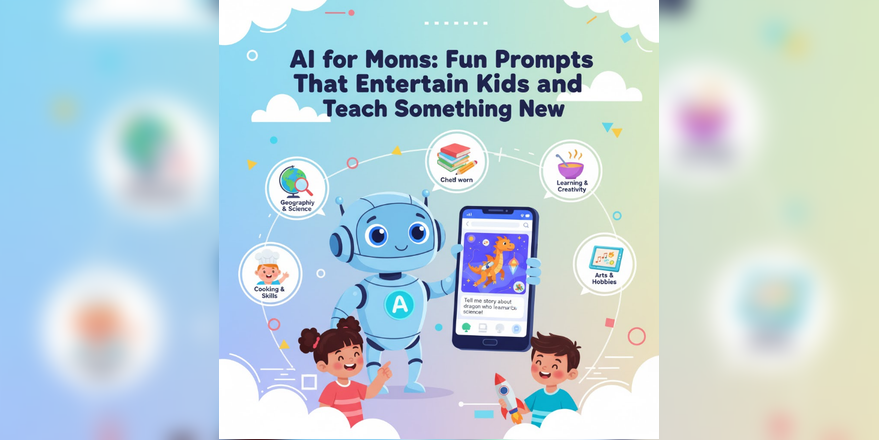AI tools like ChatGPT can help generate ideas for educational activities through creative prompts that inspire science exploration, spark creativity, develop writing skills, and encourage critical thinking. While AI interactions happen on screens, the best prompts generate ideas for offline activities, minimizing actual screen time while maximizing educational benefit. However, it’s essential to use AI as a supervised brainstorming tool rather than a replacement for parental guidance, and always verify that activities are age-appropriate and safe before letting children try them.
Critical Safety Disclaimer
Before using AI prompts with your children, understand these critical limitations:
AI can generate entirely fabricated “facts” with complete confidence, inventing historical events, scientific principles, biographical details, or statistics that sound plausible but are completely false. These hallucinations are not occasional errors—they’re a fundamental characteristic of how AI systems work. AI does not fact-check itself and cannot distinguish between accurate information and plausible-sounding fabrications.
Specific Hallucination Risks:
- Historical content: AI might invent false events, incorrect dates, made-up historical figures, or fake quotes from real people
- Science information: AI might state incorrect scientific principles, oversimplified explanations that are technically wrong, or present outdated theories as current fact
- Math problems: AI occasionally generates problems with wrong answers or provides incorrect explanations of mathematical concepts
- Experiments: AI might suggest dangerous chemical combinations or omit critical safety steps
Always cross-reference educational content with authoritative sources like textbooks, educational websites (.edu domains), encyclopedias, or subject matter experts before presenting information to children as fact.
Key Safety Guidelines:
- Verify ALL science experiments for age-appropriateness and chemical safety before attempting
- Check historical facts and educational content for accuracy using trusted sources
- Ensure creative activities don’t include inappropriate themes or take unexpected directions
- Never use AI as a substitute for professional educational or medical advice
- Supervise children’s interactions with AI tools at all times
- Review all AI-generated content before sharing with kids
- Teach children that AI can confidently provide wrong information
Trusted Verification Sources
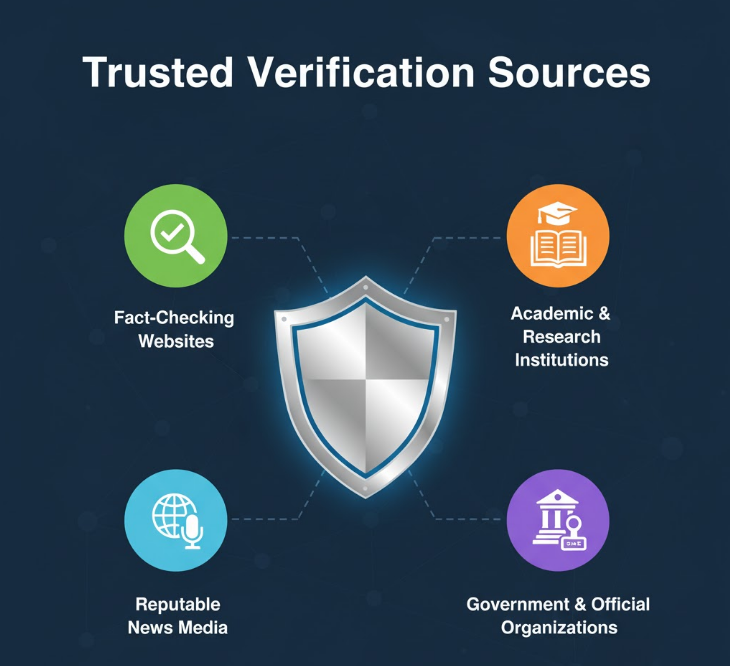
Parents should verify AI-generated content using these reliable sources:
For Science Facts:
- NASA Kids Club (nasa.gov/kidsclub)
- National Geographic Kids (kids.nationalgeographic.com)
- Science Buddies (sciencebuddies.org)
- Your local library’s educational databases
- Your child’s science teacher
For History Information:
- Britannica Kids (kids.britannica.com)
- National Archives (archives.gov)
- Educational museums’ websites (.edu or .gov domains)
- History textbooks and curriculum materials
For Science Experiments:
- Steve Spangler Science (stevespanglerscience.com)
- Science Bob (sciencebob.com)
- Your child’s science teacher
- Verified educational science websites
For General Educational Content:
- Khan Academy (khanacademy.org)
- Scholastic (scholastic.com)
- PBS Kids (pbskids.org)
Privacy and Information Safety
Protect Your Child’s Privacy:
When customizing prompts for your child, avoid including full names, school names, specific locations, or other identifying information. Use general descriptions like “my 8-year-old” rather than “My daughter Emma at Lincoln Elementary School.” AI conversations may be reviewed to improve systems, so never share:
- Full names of family members
- School names or addresses
- Home addresses or specific locations
- Phone numbers or contact information
- Medical information or diagnoses
- Financial details
Why AI Makes Learning Fun for Kids

Modern AI tools can serve as brainstorming assistants for parents seeking educational activities. When used correctly with parental supervision and verification, AI becomes a source of activity ideas that parents can adapt and implement safely.
Instant Idea Generation
Unlike searching through numerous websites, AI can quickly generate customized activity suggestions based on your child’s interests, age level, and learning needs. These serve as starting points that parents must verify and adapt.
Engagement Through Offline Activities
The best use of AI generates ideas that get children away from screens. AI can suggest experiments using household items, outdoor exploration challenges, or art projects that happen entirely offline after the initial prompt generation.
Supporting Curiosity
AI can help parents find ways to answer children’s “why” questions, though parents must verify the accuracy of explanations before sharing them with children.
⚠️ EXPERIMENT SAFETY REQUIREMENTS ⚠️
Before trying ANY AI-suggested experiment:
- Research the experiment on trusted science education sites listed above
- Verify no dangerous chemical reactions can occur by checking with chemistry resources
- Check age-appropriateness with science teachers or educational guidelines
- Ensure you have proper supervision and safety equipment (goggles, gloves, etc.)
- Read complete instructions from verified educational sources
- Never assume AI experiment instructions are complete, accurate, or safe
- Supervise ALL activities involving materials, heat, or chemicals
AI frequently omits critical safety steps, suggests unsafe material combinations, or provides incomplete instructions. Parent verification is mandatory, not optional.
Creative Writing and Storytelling Prompts
These prompts help parents generate story ideas that develop writing skills, imagination, and narrative structure understanding.
Interactive Story Creation with Content Boundaries
“Create an adventure story where I’m a young explorer who discovers a hidden city. Keep all content appropriate for age 9 with no violence, scary elements, or mature themes. Ask me questions about what I want to find there, then continue the story based on my answers.”
IMPORTANT: When using interactive storytelling prompts, specify content boundaries clearly in your initial prompt. Review each story segment before letting your child continue to the next part. AI might include inappropriate elements children mention or take stories in unexpected directions without proper constraints.
Character Development Practice
“Help me create a superhero character. Ask me 5 questions about their powers, personality, and challenges, then write a short story about their first day as a hero. Keep it appropriate for age 10 with positive messages.”
Kids learn character development fundamentals while exercising creativity, though parents should review the final story for appropriateness.
Poetry Made Fun
“Write a silly poem about my pet hamster who thinks he’s a ninja. Make it rhyme and include funny action words that an 8-year-old would enjoy.”
Poetry often intimidates kids, but AI-generated examples (reviewed by parents first) can make it accessible and entertaining.
Science and Discovery Prompts

Science prompts can generate explanations of concepts, but parents must verify accuracy before sharing with children.
Concept Explanations
“Explain how rainbows form to a curious 10-year-old using an analogy involving things they see every day. Include a simple experiment we can try at home to see light refraction.”
After receiving this prompt, parents must verify the scientific accuracy of the explanation and research proper safety procedures for any suggested experiments independently.
Nature Investigation Challenges
“Create 5 outdoor scavenger hunt challenges that teach a 7-year-old about local plants, insects, and ecosystems. Include questions to ask about each item found.”
These prompts encourage outdoor exploration, though parents should verify that suggested plants are safe to observe and that the biological information is accurate.
Math and Logic Prompts
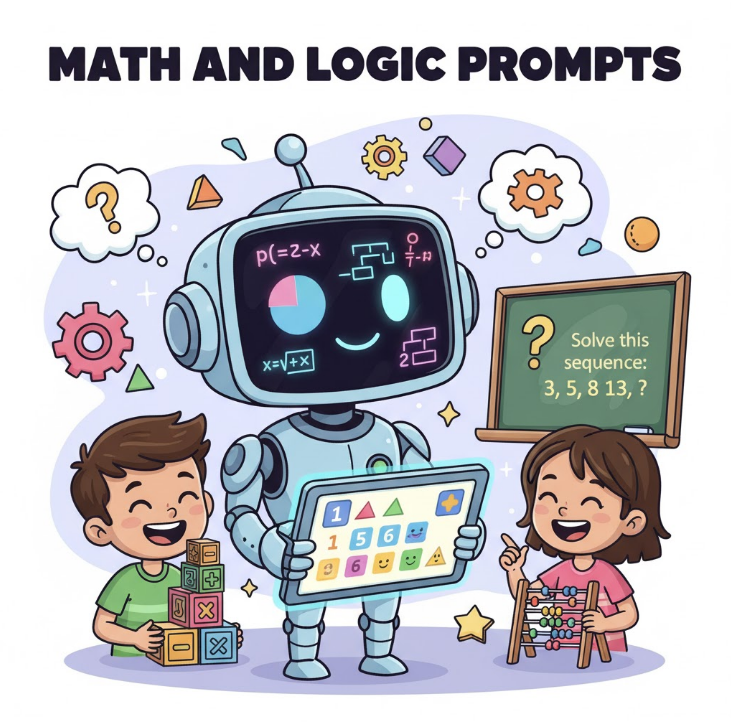
Math prompts can generate practice problems, but parents should verify solutions.
Story Problems Based on Interests
“Create 5 word problems for 3rd-grade math involving Pokemon characters. Include addition, subtraction, and basic multiplication appropriate for this grade level.”
For math activities, solve problems yourself first or check answers with calculators before presenting to children. AI occasionally makes computational errors or provides solutions with mistakes. Verify that difficulty levels match your child’s grade appropriately.
Real-World Math Applications
“Explain to a 12-year-old how percentages work using examples from video games, allowance, and shopping discounts. Include 3 practice problems they can solve.”
Verify the accuracy of explanations and check that example problems have correct solutions.
History and Social Studies Prompts

History prompts require especially careful verification due to AI’s tendency to fabricate historical details.
Historical Role-Playing with Verification
“I’m learning about Ancient Egypt. Create an interactive scenario where I’m a young Egyptian learning a trade. Ask me questions about which path I want to take, then describe daily life based on my choices.”
CRITICAL: After completing historical role-playing activities, research the actual historical period together using books or educational documentaries to separate AI’s creative elements from historical facts. AI frequently invents:
- Inaccurate details about daily life in historical periods
- False information about available trades and social structures
- Made-up cultural practices or traditions
- Incorrect dates, names, or events
Time Period Comparisons
“Explain to an 11-year-old how a typical day for a kid their age differed in 1950, 1850, and 1750. Focus on school, chores, entertainment, and technology.”
These comparisons can spark interest, but parents must verify historical accuracy using reliable history resources before presenting as fact.
Art and Creativity Prompts
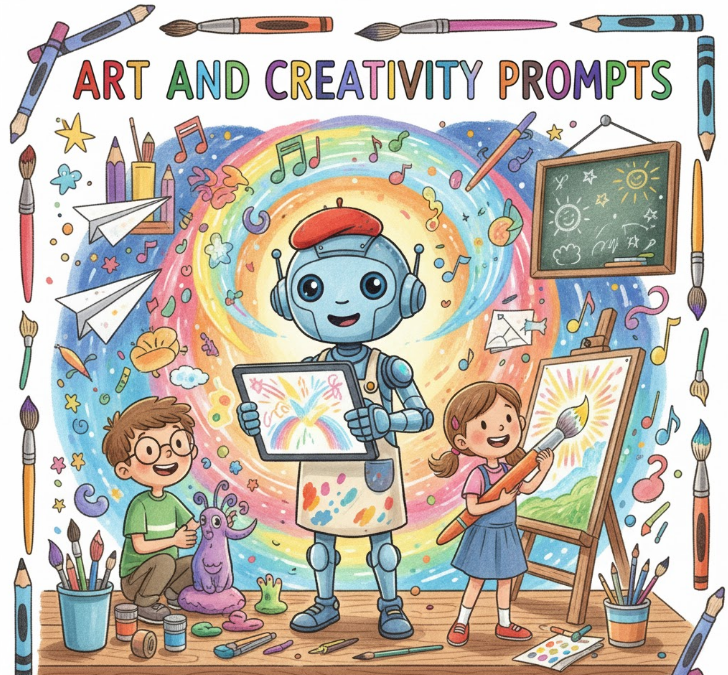
Artistic prompts inspire projects that develop fine motor skills and creative confidence.
Drawing Challenges
“Give me 5 creative drawing prompts for a 7-year-old that combine two unexpected things, like ‘a robot gardening’ or ‘a dinosaur baking cookies.’ Explain what makes each combination interesting.”
Craft Project Ideas
“Suggest 3 recycled material art projects for kids aged 8-10 that teach about environmental conservation. Include materials needed and step-by-step instructions.”
Verify that suggested materials are safe and age-appropriate.
Academic Integrity and Homework
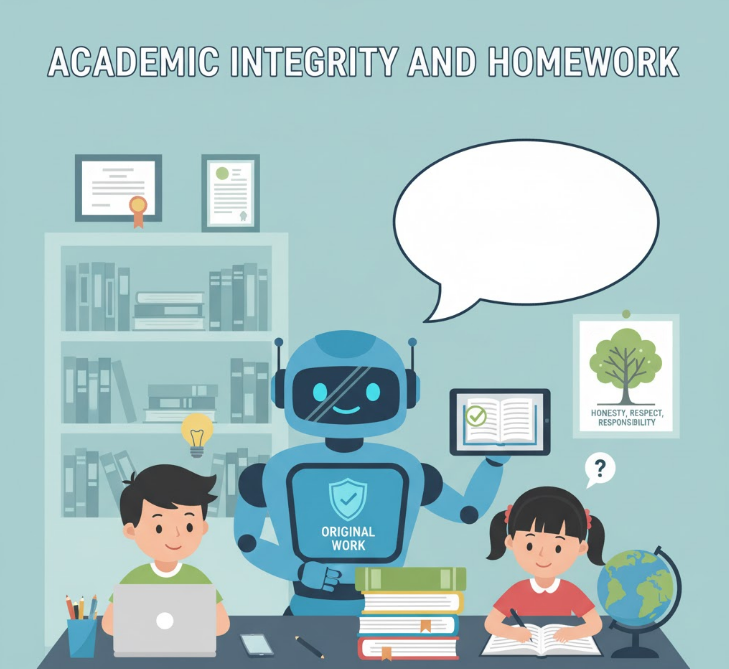
Important Note About School Work:
Many schools now consider using AI for homework to be academic dishonesty, similar to plagiarism. Check your school’s AI policy before using these tools for any school-related work. Using AI to “explain concepts” may still violate some schools’ policies, as it can substitute for the learning process students are meant to experience independently.
AI can help parents understand concepts so they can better help their children, but children should complete their own work and develop their own understanding.
Step-by-Step: Using AI Prompts Safely
Step 1: Generate Content
Use AI to create initial activity ideas, explanations, or prompts based on your child’s interests and age level.
Step 2: Verify Accuracy
Cross-reference all educational content with trusted sources listed earlier. Check facts, safety procedures, and age-appropriateness.
Step 3: Adapt for Safety
Modify AI suggestions based on your verification. Remove inaccurate information, add missing safety steps, and adjust difficulty as needed.
Step 4: Present to Child
Share the verified, parent-approved content with your child. Never let children access raw AI outputs without parental review.
Step 5: Teach Verification
Use these moments to teach children that even smart-seeming tools can be wrong. Model fact-checking and critical thinking.
Step 6: Monitor and Engage
Participate in activities together. Your involvement transforms AI from a content source into a collaborative learning tool.
Age-Appropriate AI Use
Ages 5-7:
Children this age benefit from content parents generate using AI, with the parent reading and presenting it to the child. Children should not interact directly with AI tools. Parents use AI to generate story ideas, activity suggestions, or craft projects, then verify and present the content.
Ages 8-10:
Children this age still should not interact directly with AI but can participate in activities generated through parent-verified AI prompts. Parents continue to handle all AI interactions and verification.
Ages 10-13 (with supervision):
Children who can read fluently and understand concepts like misinformation may begin supervised AI interactions with strict parental oversight. Parents must be present, review all outputs, and teach critical evaluation of AI responses.
Ages 13+:
Teens can use AI more independently but require education about its limitations, hallucination risks, academic integrity policies, and the importance of verification. Parents should maintain awareness of AI use and regularly discuss appropriate applications.
FAQs
What age is appropriate for using AI learning tools?
Children as young as 5 can benefit from content parents generate using AI, with the parent reading/presenting it to the child. Children should not interact directly with AI tools until they can read fluently and understand its limitations (typically age 10+ with supervision). Direct interaction requires the maturity to question information and understand that AI can confidently provide wrong answers.
Can AI replace traditional education?
Absolutely not. AI is a supplementary brainstorming tool that helps parents generate activity ideas but cannot replace qualified teachers, structured curriculum, peer interaction, or hands-on educational experiences. Overreliance on AI can reduce critical thinking skills and hinder cognitive development.
How do I know if AI information is accurate for my child?
You cannot know without verification. Always cross-reference AI-generated content with trusted educational resources, textbooks, or expert sources listed in this article. For science experiments, independently verify safety procedures. For historical facts, check academic sources. Never assume AI information is accurate.
Should I let my child interact directly with AI?
For younger children under 10, no. Parents should generate and review AI content before sharing. Children ages 10-13 can interact with close parental supervision, with parents present to review outputs and teach critical evaluation. Teens need education about limitations and appropriate use before independent access.
What if AI suggests something inappropriate or dangerous?
This can happen even with well-crafted prompts. Always review outputs before sharing with children. If you encounter inappropriate content or dangerous suggestions, close the chat and try rephrasing your prompt with more specific age and content guidelines. Report serious safety concerns to the platform.
Can AI help with homework?
Use extreme caution. Many schools consider AI use for homework academic dishonesty. Check your school’s policies first. AI should never complete work for children. It can help parents understand concepts to better assist their children, but children must do their own learning and work.
How do I verify science experiments are safe?
Never trust AI experiment suggestions without independent verification. Research the experiment on trusted science education sites (Steve Spangler Science, Science Bob, Science Buddies), consult with science teachers, verify no dangerous reactions can occur, and check that all safety equipment and procedures are included. Assume AI instructions are incomplete until proven otherwise.
What about privacy when creating personalized content?
Never include identifying information in AI prompts. Use general descriptions (“my 8-year-old” not “Emma Smith at Lincoln Elementary”). Avoid sharing names, school information, locations, or any details that could identify your child or family. AI conversations may be reviewed for system improvements.
Final Thoughts
AI can serve as a useful brainstorming tool for parents seeking educational activity ideas, but it requires careful, informed use. The technology’s ability to confidently generate false information makes parental verification absolutely essential, not optional. Every science fact, historical detail, and activity suggestion needs independent confirmation from trusted educational sources before presentation to children.
The key to responsible use is treating AI as one idea-generation tool among many, never as an authoritative source of information. Your role as a parent involves generating ideas with AI, thoroughly verifying content, adapting suggestions for safety and accuracy, and presenting approved activities to your children. This process takes time and effort but ensures your children receive accurate, safe, and truly educational experiences.
Teach your children from the beginning that AI is a tool that frequently makes mistakes. Building healthy skepticism, strong verification habits, and critical thinking skills now prepares them for a world where AI will be increasingly present. Model the verification process, show them how to fact-check using reliable sources, and celebrate the detective work involved in confirming or disproving AI suggestions.
Start conservatively by using AI to generate simple activity ideas that you thoroughly verify before implementation. As you become familiar with AI’s patterns, limitations, and common errors, you’ll develop better judgment about what requires extensive verification versus what needs only quick confirmation. Remember that your involvement, guidance, and verification transform AI from a potential source of misinformation into a helpful brainstorming assistant that supplements quality parenting. Happy learning!

